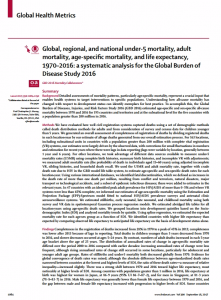
Detailed assessments of mortality patterns, particularly age-specific mortality, represent a crucial input that enables health systems to target interventions to specific populations. Understanding how all-cause mortality has changed with respect to development status can identify exemplars for best practice. To accomplish this, the Global Burden of Diseases, Injuries, and Risk Factors Study 2016 (GBD 2016) estimated age-specific and sex-specific all-cause mortality between 1970 and 2016 for 195 countries and territories and at the subnational level for the five countries with a population greater than 200 million in 2016.
Compared with GBD 2015, the main changes that are reflected in this study include updates to data, methods, and presentation (Research in context panel). We use the time trend to 2016 to explore patterns by age and location, assess the convergence of absolute and relative mortality rates, and examine which countries have higher than expected life expectancy on the basis of their level of development using consistent methods and a comprehensively updated database. Because we re-estimate the entire time series from 1970 to 2016 for all-cause mortality, additions to data and revisions to methods mean that results from this study supersede all prior GBD results for all-cause mortality.